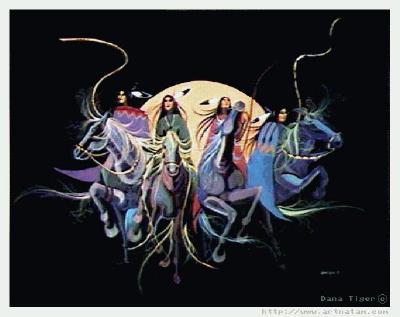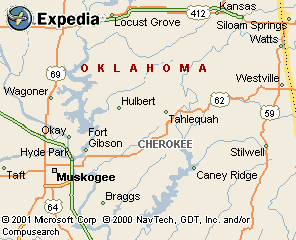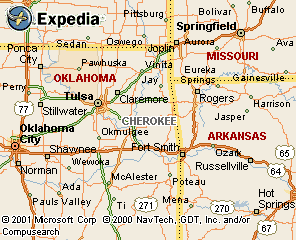|
|
Canku Ota |
|
|
(Many Paths) |
||
|
An Online Newsletter Celebrating Native America |
||
|
June 16, 2001 - Issue 38 |
||
|
|
||
|
American Indian Artist Shares Culture with Community |
||
|
art Warrior Women by Dana Tiger |
 Dana Tiger
follows her father's footsteps, feels his presence near her, lives his legacy. Dana Tiger
follows her father's footsteps, feels his presence near her, lives his legacy.When she reached the crossroads of despair and survival more than 16 years ago, she said, his spirit reached her, reminded her of her heritage and picked her back up. Now, the Cherokee/Creek/Seminole artist wants to do the same for other native youths. And she is — through the creation of the Legacy Cultural Learning Community, to be located on the border of Cherokee and Sequoyah counties in northeastern Oklahoma. Tiger will sell 360 of her prints, each with an original touch, during the Red Earth 2001 Festival, which was held the weekend of June 9th. For the 15th year, Red Earthhosted members from more than 150 American Indian nations from throughout North America. Organizers bill it as “America's Largest Native American Cultural Festival.” It featured more than 750 works of art by top American Indian painters, sculptors, jewelry makers and others in the art market; drum groups and dancers from Northern and Southern tribes; a youth art market and authentic American Indian cuisine. Through the sale of the prints, Tiger said, she hopes to pay for the land she has bought for the Legacy project. More donations have already been made for the construction of the buildings. The community will have a Cherokee museum, cabins for lodging and a center where instructors will teach American Indian youths about their culture and their art. "Next year, we’ll be teaching there. I can hardly believe that next year we'll be helping them, helping them change their lives around," Tiger said in a telephone interview from her home studio near Keys, OK.  For Tiger, the cultural community is the perfect blend of art and activism — the two things to which she has committed her life. "Daddy left me his legacy when he died. This is my chance to leave mine." Jerome Tiger died of an accidental, self-inflicted gunshot wound to the head when his eldest daughter was only 5 years old. But now, at 39, Tiger still remembers her father as a "magnetic, charismatic man." "He was so full of life," Tiger said. "He would just draw people to him. Our house was always full of people because of him. He was so sweet, generous and kind. That’s what attracted others to him as much as his paintings did." A high school dropout and street and ring fighter, Jerome Tiger created a self-named painting style combining spiritual vision, humane understanding and technical virtuosity. With little formal training, he sustained himself as an artist, creating hundreds of paintings that would receive nationwide acclaim and recognition. While some American Indian artists scrutinized every detail of his paintings, others knew that Jerome Tiger had come to define contemporary Indian art. His daughter continues his art today with the added satisfaction of seeing the painting style he created becoming even more accepted by other American Indian artists. Especially at Red Earth. "That the festival's in Oklahoma featuring the best artists in the state is what makes it so special. It's like a homecoming," Tiger said. "It's the biggest show of the year for me." In addition to the prints she will be selling for the Legacy project, Tiger will have more than 20 originals for sale. "This will be a first for me, bringing so many originals." After being diagnosed in 1999 with Parkinson's disease, Tiger, for awhile, had to slow down her work. But that ended this year. "I’m feeling better than ever now," she said. "In fact, I've never felt so good or loved life so much. I think people will see that in my paintings." Tiger has conquered her shaking leg and the symptoms of the debilitating illness by taking experimental treatments in Germany. "I'm still on medicine, but instead of taking higher dosages, I'm taking less and less. Life was horrible before," she said. "I had such anxiety about what could be wrong with me that the ideas for my art wouldn't flow, wouldn’t come freely. It was only through sheer determination that I was able to create anything at all during that time." After all, quitting isn't in Tiger's blood. "Thank goodness I didn't just lay down and quit. If I had, I wouldn't have this zest for life now. The colors in my paintings help me express my love for life." |
|
You can see where the Community will be on the maps below |
|
|
|
Dana Tiger |
|
|
||
|
|
||
| Canku Ota is a free Newsletter celebrating Native America, its traditions and accomplishments . We do not provide subscriber or visitor names to anyone. Some articles presented in Canku Ota may contain copyright material. We have received appropriate permissions for republishing any articles. Material appearing here is distributed without profit or monetary gain to those who have expressed an interest. This is in accordance with Title 17 U.S.C. section 107. | ||
|
Canku Ota is a copyright © 2000, 2001 of Vicki Lockard and Paul Barry. |
||
|
|
|
|
|
The "Canku Ota - A Newsletter Celebrating Native America" web site and its design is the |
||
|
Copyright © 1999, 2000, 2001 of Paul C. Barry. |
||
|
All Rights Reserved. |


